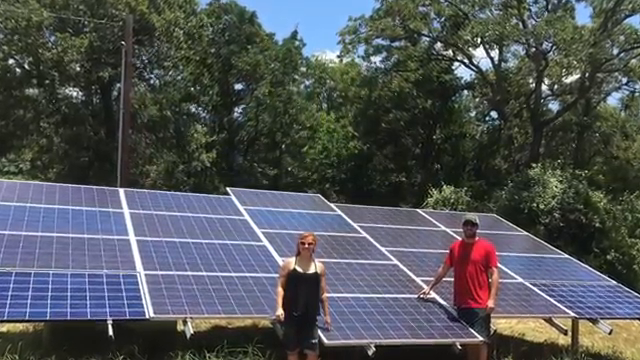Empowering Entrepreneurs: Interview with Rene Geneva, Powering Independence through Solar
Meet Rene Geneva, CEO and Lead Solar Designer of Indie Solar
Why did you pursue Indie Solar?
That list up there of community improvements? Healthcare, education… Notice electricity hasn’t made the guest list. For reasons,
- Solar is expensive, like, super expensive.
- Solar is smart, like, you have to understand a holy-moly amount of stuff to design off-grid solar and battery based systems that work.
- Solar is so heavy. PV panels, 50lbs; inverters, 100lbs; batteries, 150lbs! One community I visited had a solar array accessed by 4X4ing a wet-weather creek bed + climbing over a ravine only after trekking about 3 miles on foot. A whole solar array was installed out there - all 3500lbs. Heavy = shipping + logistics nightmare.
Indie Solar gives me a sense of purpose to make solar pv better and bring more of it into the world. When I started Indie Solar in 2010, specializing in off-grid and mobile systems, there were only a handful of competitors worldwide and we’re likely friends. The high end clients we serve (think, Willie Nelson) have been willing to invest the amount of money it currently takes to make solar power a reality in our first world. Which in turn, has allowed us to develop revolutionary solar technology that is affordable.
You have created fun videos and you are the Lead Solar Designer and CEO – how do you have time for all of this work?
I strive for balance in life, and have an amazing team - many whom have been working for me since we opened our doors. Lead Solar Designer at this point, kind of means that I have veto power - but we have a design team that does the heavy lifting. I also have a panel of advisors - while utilizing coaches and mastermind groups. I say “no” a lot to new projects that may be wonderful - but not consistent with our vision. I’m also 'hella' organized, enjoy making lists and finishing tasks, which helps make the most of my time.
Why incorporate Whole Planet Foundation as your charitable giving?Whole Planet Foundation embodies what Indie Solar is trying to achieve with the VANOPY: create independent communities through empowering entrepreneurs with the means and skills to work. I imagine a world where women can use their microcredit opportunity to make a business with our Vanopies - by setting up an off-grid, solar-powered charging kiosk for communities with little to no electricity. A solar powered generator that uses our Vanopies can weigh hundreds of pounds less than what’s available to them today. Together, Indie Solar, Whole Planet Foundation and those who join the effort can empower entrepreneurs, one solar panel at a time.
Tell us about your motivation to create the Vanopy and push solar forward?
I’ll swing this back around to the addressing the reasons why solar isn’t as popular as you think it should be:
- The cost. The Vanopy is affordable enough and its the only solar panel canopy of its kind. That puts us in a prime market position to start where we need to on price and work at lowering the costs as we grow.
- The simplicity of design. It took an embarrassing amount of years to land on the final design of the Vanopy - which is the most obvious one - a solar rectangle on a canopy rectangle. Pairing the design down to it’s simplest form allowed us to concentrate on complicated issues - like developing solar that rolls tight or sourcing textiles that can withstand years of road life. The Vanopy’s unibody has also lowered our manufacturing costs by stripping out unnecessary cutting and sewing of seams.
- The weight. Did I mention the Vanopy - a full size, full power solar panel - only weighs 6 lbs? That’s 2.7kg. That’s crazy talk. If I’ve had one dream through this entire process - since I met the poor chaps that dragged solar on their backs through the Campo - it’s to make solar power accessible. With the Vanopy, we are making solar accessible.
How did you arrive here from clothing design supporting microentrepreneurs in Nicaragua?
About 3 years after we had a several month training session in one of these communities, a former student approached me. He now owns a business making his surf board covers and was destined to give his family the future he envisioned. It was that moment that I realized how much impact a person can make in someone’s future - by providing education and an example to aspire to. In the end, I can teach a family how to sew but you can’t do that without power, which was a constant problem in that area. Yet it’s going to take an army to teach the world solar electricity and more advanced, smaller, and less expensive products are necessary for photovoltaics to flourish. That’s the switch for me right there - from fashion to solar power.
What makes the Vanopy special in that it fuels your desire for independence for you and your family and other families?
The VANOPY is a means to freedom. Freedom to roam with your own power center, work from the road, help disaster areas, and give entrepreneurs the means to create a new business. The more we grow, the more jobs we create, and the more we’re able to give back.
The making of the Vanopy includes using advanced technology and that means playing with robots - which is too cool. It also means coming together with leading minds and making a true and legit difference. It took four years of product development, from the solar cell up, listening to advisors, test marketing, 3 years of product beta testing, and over $60,000 in sales to bring the Vanopy to market. That’s a whole lot of exciting and it’s been easy to be optimistic, even through the difficult periods (like when our first solar cell provider went belly-up and we had to restart at square one). We’re surrounded by friends, family, and clients that fiercely support our mission and motivate us to grow in a way that is consistent with our core values.
Indie Solar is poised to go big. What’s your 5-year dream?
Great question - As backstory, know that we are currently in year 4 of VANOPY product launch plan and it’s amazing. And surprise, I actually do have a 5-year follow up plan for Indie Solar.
Our business currently consists of two departments. 1. Off-grid solar installation, including city work and on RVs (where you can vacation in Pong - our flagship solar-powered Airstream in Austin, Texas while your home on wheels gets the full-solar treatment). And 2. The solar panel product manufacturing side - where we make the Vanopy and also make solar powered battery generators and DIY solar panel kits for RVs. I hope to sell the installation side of the business and focus solely on inventing solar solutions and getting them out into the marketplace. We are in partnership with our solar cell manufacturer and already designing a Vanopy prototype that’s more integrated for those who like to travel with solar in their luggage.
Financially - I fully expect this to be over a million dollar business by the end of next year. So much has gone into the product, the quality, the processes, warranty, viability, market research, risk mitigation, and that’s in addition to the blood, sweat, and tears. We’re confident that our plan to scale will have minimal and mostly-prepared for hiccups.
What’s your advice to aspiring entrepreneurs who want to embed a cause in their business strategy?
Know your business, know your customer base, and bring on a cause that is mutually beneficial to your goals and aligns with your values. Then have a detailed plan.
Learn more about the Vanopy and join Indie Solar's Indiegogo Campaign supporting Whole Planet Foundation


